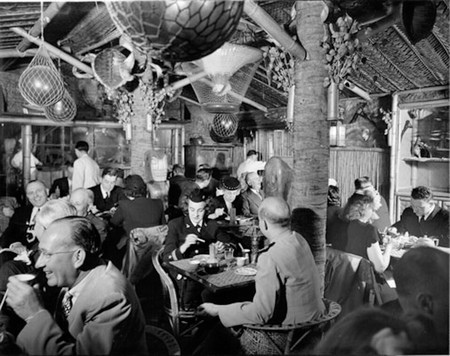The Creme de la Crème; SF’s Culinary History: Part 8 of 12

In 1922, Italian restaurateur Julius Roz opened Julius' Castle on Telegraph Hill. Highly popular amongst celebrities for its magnificent bay view and discrete location beneath Coit Tower, after multiple changes in ownership and cuisine -- from American to Italian, then Continental to French, business at the landmark restaurant dwindled and it closed in 2008. Currently, the property remains on the market for the next big bidder.
At one time, Ernie's on Montgomery Street was considered the best fine dining establishment in San Francisco, by locals and the media alike. When Chef/Owner Ernie Carlessos first opened Ernie's in 1931, it was a modest Italian trattoria. By the late 1940s, Ernie took the restaurant into an entirely different direction: he turned it into a white table-cloth French restaurant catering exclusively to the elite. Extravagant dishes such as Crêpes Suzettes were served and some of the most notable regulars included people like the brilliant Alfred Hitchcock. His abiding fondness of Ernie's even prompted Hitchcock's decision to film one of his most prized classics there -- "Vertigo." But as San Francisco's dining scene expanded and fine dining became increasingly competitive and diverse, the restaurant’s popularity began to fade. In 1995, Ernie's closed its doors forever.
The extravagant Palace Hotel on Montgomery Street, now the Sheraton-Palace, is the source of two historically significant culinary creations. In 1910, Chef Ernest Arbogast invented Chicken Tetrazzini for an Italian opera singer named Luisa Tetrazzini. Served over pasta, this rich chicken dish calls for a cream sauce with almonds, parmesan, and wine. In 1923, the Palace Hotel's Chef Philip Roemer created the Green Goddess Salad Dressing. Named after the play "The Green Goddess," the dressing was a tribute to the English actor George Arliss (also a hotel guest), who was performing the play’s lead role. The dressing is a mixture of mayonnaise, anchovies, tarragon, vinegar, parsley, scallions, garlic, and other spices.
Trader Vic's restaurant was a legendary part of San Francisco. To dine there was to embark on a great adventure of being taken away by its island-inspired ambiance and exotic Polynesian food and tropical drinks. Founder Victor Jules Bergeron, Jr. opened the first Trader Vic's in Oakland, in 1934. He was also a master mixologist and is credited for inventing the Mai Tai. In 1951, Bergeron took the Trader Vic's experience to San Francisco at Cosmo Place near Nob Hill. The food was both extraordinary and elegant. Even dishes as messy as barbecue spareribs were served with finesse. The Bongo Bongo soup was a Trader Vic's specialty, which some believe was inspired by a dish called Boula Boula that is a pea purée and turtle soup. In the Trader Vic's recipe, Pacific oysters are used instead of turtle. Despite the restaurant’s popularity over the decades, Trader Vic's met its end in 1994. Though unfortunate that the San Francisco location did not survive, others around the world have. The Emeryville location, which opened in 1972, is now the flagship restaurant and Trader Vic's Palo Alto has been open since 2001.
The Tonga Room at the landmark Fairmont Hotel in Nob Hill is the only remaining original Tiki restaurant in San Francisco, and one of the few left in the state. Since it opened in 1945, people have been enamored by its elaborate tropical setting created by the simulated rain and thunder storms amidst the lake that sits in the middle of the restaurant. Pacific Rim Asian cuisine is served family-style and features various traditional pupus (appetizers), seafood flown in directly from Hawaii, and other exotic dishes such as Kalua Pork.
San Francisco's Culinary History: Part 1 of 12
The Iconic Foods of San Francisco; San Francisco’s Culinary History: Part 2 of 12
Culinary Institutions; San Francisco’s Culinary History: Part 3 of 12
Fisherman's Wharf; San Francisco’s Culinary History: Part 4 of 12
North Beach; San Francisco’s Culinary History: Part 5 of 12
The Mission; San Francisco’s Culinary History: Part 6 of 12
Nostalgia; San Francisco’s Culinary History: Part 7 of 12
The Creme de la Crème; San Francisco’s Culinary History: Part 8 of 12
Asian Influence; San Francisco’s Culinary History: Part 9 of 12
The Veggie Scene; San Francisco’s Culinary History: Part 10 of 12
Ice Cream Goodness; San Francisco’s Culinary History: Part 11 of 12
Food Forward; San Francisco’s Culinary History: Part 12 of 12
Copyright TableAgent.com
© Restaurant Agent Inc.